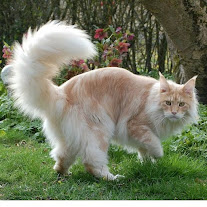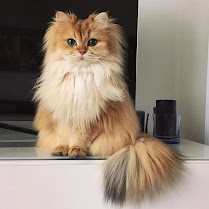Breeds 𓂃 ࣪˖ ִֶָ𐀔
List of Cat Breeds 𓏲 ๋࣭ ࣪ ˖
- Balinese Cat.
when the first Siamese cats were imported to the U.S. and the UK from Thailand. Breeders soon noticed that purebred Siamese cat litters sometimes contained longhaired kittens.
At first, these kitties were sold as pets only. In 1928, the American Cat Fanciers’ Federation allowed registration as “Long-haired Siamese” and by the 1950s, breeders were selecting for the long-haired genetic trait.
We have one of the first Balinese cat breeders to thank for giving the breed its name: Helen Smith felt that the term “long-haired Siamese” was too cumbersome. She named the breed after Balinese dancers, known for their beauty and grace.
Source: Balinese Cat Breed: Size, Appearance & Personality (cats.com)
- Maine Coon Cat.
the Maine Coon cat is a native of the state of Maine. Endemic to the United States of America, this breed probably originated in the 1850s, when long-haired cats were brought to America and mated with local short-haired cats. The result was a hearty, healthy, large cat with incredible hunting prowess; a heavy, shaggy coat; and a long, flowing tail.
The breed was exhibited at cat shows throughout the late 19th century. Farmers who prized these cats for their outstanding ability to keep barns and outbuildings free from rodents held their own competition, called the Maine State Champion Coon Cat contest at the Skowhegan Fair.
Maine Coon cats fell out of fashion during the early 20th century, when more exotic long-haired cat breeds such as Persians came to the United States. The breed declined until the 1950s, with some people believing the Maine Coon might have even become extinct.
Source: Maine Coon Cat Breed: Size, Appearance & Personality (cats.com)
- British Long Hair Cat.
The British Longhair is a relatively new breed, having descended directly from the British Shorthair cat. By the end of the first world war, the British Shorthair population had dropped dramatically. Breeders worked hard to save these incredible cats by outcrossing with several other breeds including Persians.
Kittens with long hair did not qualify as British Shorthairs, however they made excellent pets, as they shared many of the traits that make the breed so popular.
The British Shorthair cat breed was nearly decimated again during the second world war, leading breeders to outcross again. In addition to Persians, British Shorthairs were crossed with Burmese, Chartreux, and Russian Blue cats. Once again, kittens with medium to long hair were not accepted for registry.
Source: British Longhair Cat Breed: Size, Appearance & Personality (cats.com)
- Bengal Cat.
Cat fanciers began experimenting with Asian Leopard cat hybridization more than 200 years ago, but the Bengal cat we know and love today didn’t emerge until the 1960s, when Dr. Willard Centerwall of Loma Linda University began hybridizing Asian Leopard cats to see whether they would pass their immunity to feline leukemia on to hybrid offspring. While immunity wasn’t passed on, something great did result from those early experiments: the beginnings of a future new cat breed.
It took decades for Bengal cats to become standardized. In 1980, Dr. Centerwall sent some of his Bengal cats to Jean Mill, who wanted to decrease the desire for fur as a fashion statement by popularizing domestic cats with exotic looks. At the same time, she hoped to reduce the demand for illegal trafficking in wild cats for the pet industry.
Source: Bengal Cat Breed: Size, Appearance & Personality (cats.com)
- Donskoy Cat.
The first foundation member of this rare cat breed was first encountered in Russia in 1987 when a professor named Elena Kovaleva rescued a kitten that was being mistreated by a group of boys.
The kitten was partially hairless, leading Elena to attempt all kinds of treatments in an effort to restore it's coat - but to no avail. After some time, the cat, now named Varvara, had a litter of kittens that included some with hair and some without hair. Those born with hair soon lost part or all of their coats, and it was determined that Varvara had a genetic mutation rather than a skin disease.
Source: Donskoy Cat Breed: Size, Appearance & Personality (cats.com)







